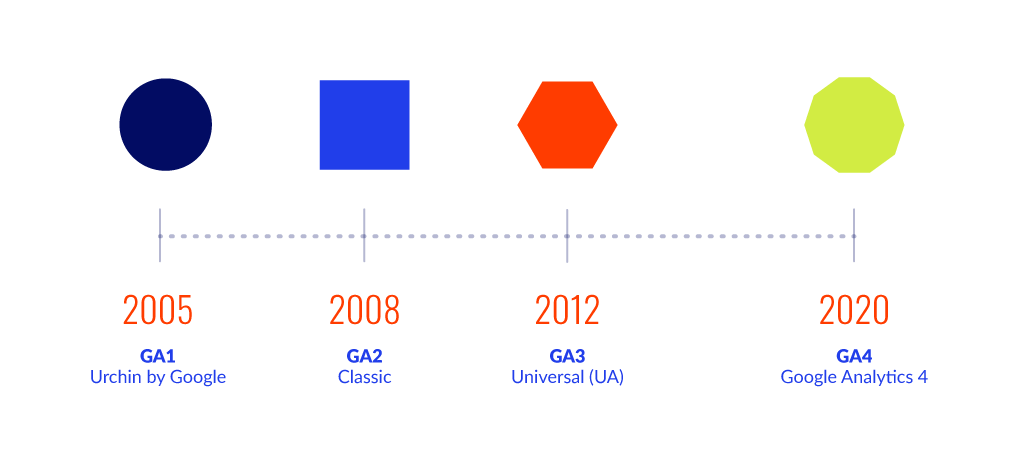How can we help you?
We want to hear from you. And it’s easy to reach us. Give us a shout at 844-886-2252, send us an email at hello@mediumgiant.co, visit our contact page, or fill out the form right here. You can expect a response within two business days.
What are you looking for?
GA4: What you need to know about Google’s latest analytics release
The current form of Google Analytics (Universal Analytics) is sunsetting on July 1, 2023. A new version that launched in 2020, called Google Analytics 4 (GA4), will take its place.
We believe this is a massive opportunity for brands to reset their analytics and site data. The pandemic has impacted site traffic in numerous ways, and this analytics update is the perfect time to get your data right.
What is GA4 really?
GA4 is a shift to a more sustainable analytics model. This new version is due to Google planning ahead for the future where cookies don’t exist and privacy is a growing concern for the worldwide population. With Google’s leverage of industry-standard machine learning, gaps in data caused by these limitations are rather opportunities to find customers most likely to convert. This forward-looking approach allows future-proof analytics for your business.

And yes, this is the fourth iteration of the most used analytics platform on the web. The history goes something like this:
- GA1: Urchin, 2005
- GA2: Classic, 2008
- GA3: Universal, 2012
- GA4: We are here, 2020
GA4 improves upon the previous iteration of Universal Analytics by providing features only previously available to GA360 users, a more advanced tool for paid users.
This is also the first time we’ll see a major facelift to the GA user interface (UI). Google is overhauling the look and feel of the tool to modernize it and align it with its current design standards.
The best features of the new GA4 are the event tracking options. Universal Analytics prioritized page views and required a tag manager, or custom coding, to track more advanced features:
- File engagement
- Outbound clicks
- Video views
These options are now out-of-the box features you can enable during your GA4 setup.
The last notable new feature is the integration of web and app data under the same roof. Universal Analytics traditionally tracked web while Firebase tracked app data. Now these two areas can be combined in GA4 to give you a more comprehensive view of your web and app data. This allows you to see a full-picture view of your business and how it’s performing. In the past, answering this question required workarounds that caused limitations in how your web or app data was collected. Or it would require exporting Excel files to answer top-level questions. With the correct planning and implementation, your tracking will be even more robust than before.
Measurement model paradigm shift
Let’s get the biggest change out of the way — Universal Analytics used the Pageview as its anchoring action. When you’re looking at Universal Analytics, it all revolves around the Pageview with events occurring between pageviews. GA4 has turned that on its head and made Pageviews just another event. This change allows for a significant amount of flexibility.
Another example of this paradigm shift is the focus on parameters. In Universal Analytics you are only able to set up events with three parameters: Event Category, Event Action, and Event Label. GA4, on the other hand, allows for up to 100 unique parameters, which is another huge shift in flexibility! But with flexibility comes complexity. We recommend using an expert to help you set up GA4 to your specific business case.
Customer view focused
In the past, looking at your customer was a secondary view, with the focus being on Visit level data. Google has shifted to looking at your data on a Customer level. This lets you more easily see the impact of marketing on your customer life cycle and how each element leads to visits and conversions on your site. This is shown in four types of reports:
- Acquisition
- Retention
- Engagement
- Monetization
Greater reporting flexibility
Universal Analytics used standard reports that were inflexible and difficult to get to the data you wanted. GA4 is a completely different animal, with not only the ability to edit standard reports but also the ability to add new Report Types and custom-built reports and views. This allows you to modify GA4 to match your business use case.
Should I migrate to GA4?
It depends on your current maturity and use of web analytics. If you are an advanced user, then jump into GA4 to learn about the tool.
We recommend experimenting with both tools before making the full transition. You can run GA3 and GA4 in parallel to compare and contrast the differences.
Google provides comprehensive documentation and a helpful GA4 setup wizard to make your migration simple.
If you aren’t as confident in your past data, then now is the time for an analytics reset.
Analytics reset
We see this all the time. Someone set up Google Analytics a long time ago, but a new site, site redesign/changes, or new initiatives have made the reporting outdated and unhelpful.
This GA4 transition is a great time to take stock of your company’s needs and set up your analytics in a way to deliver actionable insights.
You should also think about how your business might have changed since you last set up your analytics. The pandemic changed how many companies operate; think about all the restaurants that added online ordering or apps to serve their customers during that time.
Making sure you are tracking and measuring the right things will help inform your business objectives and needs for the future.
Taking action on data

Gathering data for data’s sake isn’t helpful. We believe in using data to experiment and make decisions that will help accelerate growth for your business.
GA4 can help marketers in two significant ways: shifting to a more sustainable model and resetting your analytics to ensure it’s reflective of your business as it is today, and not where it was when you originally set up GA.
Do we stick with Google at all?
The reality is that not all organizations will need GA4. It is a very robust tool that requires constant maintenance to provide actionable insights for your business.
Depending on your company’s size and type, how you use data, and your business approaches to visitor privacy, there are analytics alternatives that could serve you better:
- Heap — Combines quantitative and qualitative analytics to better understand the customer journey.
- Piwik Analytics — Focuses on user privacy and data security.
- Matomo — GA alternative that gives you data ownership.
Moving forward with better data insights
Understanding how your customers find and interact with your business is invaluable. And it’s only achievable if you have your analytics tools set up in the right way.
Our analytics experts deliver actionable insights across myriad industries, including B2B, ecommerce, banking, retail, and more.
Laying the foundations of data with a clean GA4 install and using that data to make decisions will bring more value to your business.
GA4: What you need to know about Google’s latest analytics release
The current form of Google Analytics (Universal Analytics) is sunsetting on July 1, 2023. A new version that launched in 2020, called Google Analytics 4 (GA4), will take its place.
We believe this is a massive opportunity for brands to reset their analytics and site data. The pandemic has impacted site traffic in numerous ways, and this analytics update is the perfect time to get your data right.
What is GA4 really?
GA4 is a shift to a more sustainable analytics model. This new version is due to Google planning ahead for the future where cookies don’t exist and privacy is a growing concern for the worldwide population. With Google’s leverage of industry-standard machine learning, gaps in data caused by these limitations are rather opportunities to find customers most likely to convert. This forward-looking approach allows future-proof analytics for your business.

And yes, this is the fourth iteration of the most used analytics platform on the web. The history goes something like this:
- GA1: Urchin, 2005
- GA2: Classic, 2008
- GA3: Universal, 2012
- GA4: We are here, 2020
GA4 improves upon the previous iteration of Universal Analytics by providing features only previously available to GA360 users, a more advanced tool for paid users.
This is also the first time we’ll see a major facelift to the GA user interface (UI). Google is overhauling the look and feel of the tool to modernize it and align it with its current design standards.
The best features of the new GA4 are the event tracking options. Universal Analytics prioritized page views and required a tag manager, or custom coding, to track more advanced features:
- File engagement
- Outbound clicks
- Video views
These options are now out-of-the box features you can enable during your GA4 setup.
The last notable new feature is the integration of web and app data under the same roof. Universal Analytics traditionally tracked web while Firebase tracked app data. Now these two areas can be combined in GA4 to give you a more comprehensive view of your web and app data. This allows you to see a full-picture view of your business and how it’s performing. In the past, answering this question required workarounds that caused limitations in how your web or app data was collected. Or it would require exporting Excel files to answer top-level questions. With the correct planning and implementation, your tracking will be even more robust than before.
Measurement model paradigm shift
Let’s get the biggest change out of the way — Universal Analytics used the Pageview as its anchoring action. When you’re looking at Universal Analytics, it all revolves around the Pageview with events occurring between pageviews. GA4 has turned that on its head and made Pageviews just another event. This change allows for a significant amount of flexibility.
Another example of this paradigm shift is the focus on parameters. In Universal Analytics you are only able to set up events with three parameters: Event Category, Event Action, and Event Label. GA4, on the other hand, allows for up to 100 unique parameters, which is another huge shift in flexibility! But with flexibility comes complexity. We recommend using an expert to help you set up GA4 to your specific business case.
Customer view focused
In the past, looking at your customer was a secondary view, with the focus being on Visit level data. Google has shifted to looking at your data on a Customer level. This lets you more easily see the impact of marketing on your customer life cycle and how each element leads to visits and conversions on your site. This is shown in four types of reports:
- Acquisition
- Retention
- Engagement
- Monetization
Greater reporting flexibility
Universal Analytics used standard reports that were inflexible and difficult to get to the data you wanted. GA4 is a completely different animal, with not only the ability to edit standard reports but also the ability to add new Report Types and custom-built reports and views. This allows you to modify GA4 to match your business use case.
Should I migrate to GA4?
It depends on your current maturity and use of web analytics. If you are an advanced user, then jump into GA4 to learn about the tool.
We recommend experimenting with both tools before making the full transition. You can run GA3 and GA4 in parallel to compare and contrast the differences.
Google provides comprehensive documentation and a helpful GA4 setup wizard to make your migration simple.
If you aren’t as confident in your past data, then now is the time for an analytics reset.
Analytics reset
We see this all the time. Someone set up Google Analytics a long time ago, but a new site, site redesign/changes, or new initiatives have made the reporting outdated and unhelpful.
This GA4 transition is a great time to take stock of your company’s needs and set up your analytics in a way to deliver actionable insights.
You should also think about how your business might have changed since you last set up your analytics. The pandemic changed how many companies operate; think about all the restaurants that added online ordering or apps to serve their customers during that time.
Making sure you are tracking and measuring the right things will help inform your business objectives and needs for the future.
Taking action on data

Gathering data for data’s sake isn’t helpful. We believe in using data to experiment and make decisions that will help accelerate growth for your business.
GA4 can help marketers in two significant ways: shifting to a more sustainable model and resetting your analytics to ensure it’s reflective of your business as it is today, and not where it was when you originally set up GA.
Do we stick with Google at all?
The reality is that not all organizations will need GA4. It is a very robust tool that requires constant maintenance to provide actionable insights for your business.
Depending on your company’s size and type, how you use data, and your business approaches to visitor privacy, there are analytics alternatives that could serve you better:
- Heap — Combines quantitative and qualitative analytics to better understand the customer journey.
- Piwik Analytics — Focuses on user privacy and data security.
- Matomo — GA alternative that gives you data ownership.
Moving forward with better data insights
Understanding how your customers find and interact with your business is invaluable. And it’s only achievable if you have your analytics tools set up in the right way.
Our analytics experts deliver actionable insights across myriad industries, including B2B, ecommerce, banking, retail, and more.
Laying the foundations of data with a clean GA4 install and using that data to make decisions will bring more value to your business.




